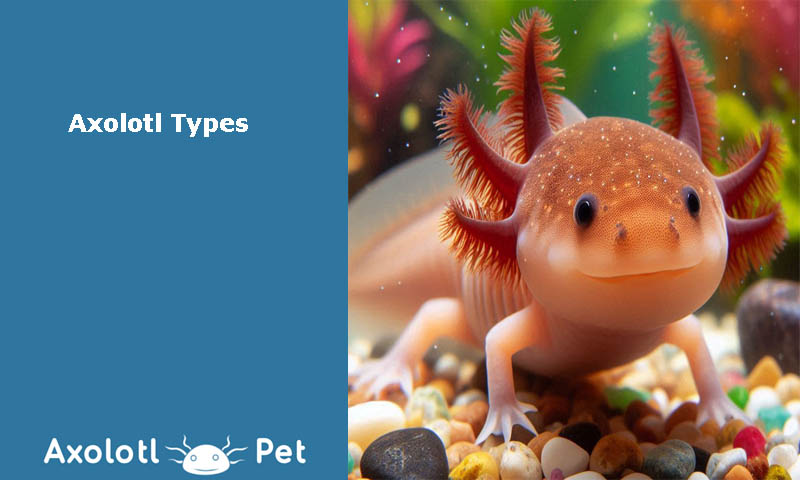Axolotls Types
Axolotl come in various types, or morphs, each showcasing distinct colors and patterns. Understanding the different axolotl types can enhance your appreciation for these fascinating animals.
From the popular golden albino to the rare axanthic, each type of axolotl has its unique characteristics that make it special.
We will explore the various axolotl types, delving into their defining features and what sets them apart in the colorful world of these remarkable amphibians.
Here are various axolotl types:
- Golden Albino Axolotl
- Copper Axolotl
- Leucistic Axolotl
- Melanoid Axolotl
- Hypomelanistic Axolotl
- Mosaic Axolotl
- Piebald Axolotl
- Wild Axolotl
- GFP Axolotl
- Axanthic Axolotl
Here’s a more detailed explanation for each of the 10 recognized axolotl types:
1.) Golden Albino Axolotl
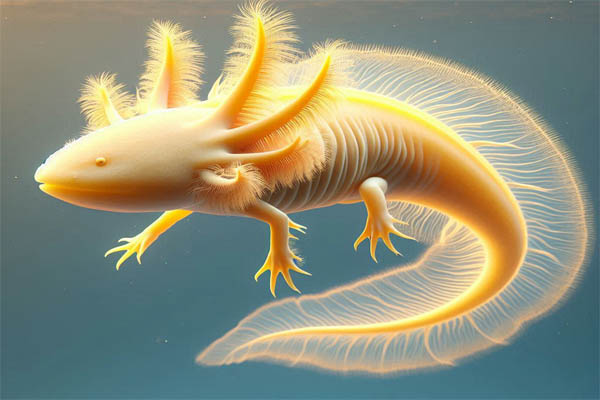
Golden albino axolotls are characterized by their bright golden-yellow coloration and distinctive pink or red eyes.
Unlike other axolotls, they lack any dark pigmentation, giving them a striking and vibrant appearance.
Their light color makes them more sensitive to light, which is important to consider in their habitat setup.
This morph is quite popular among hobbyists due to its unique look and is often sought after for breeding.
2.) Copper Axolotl
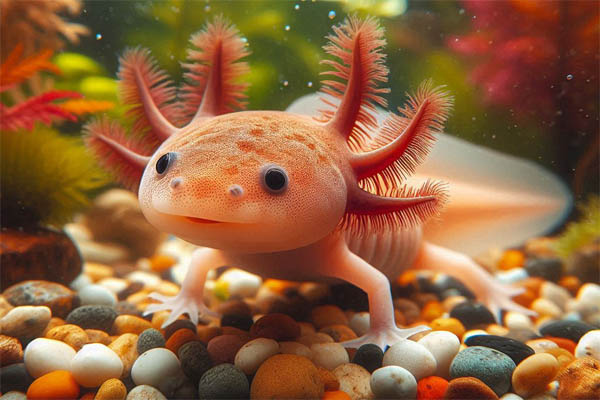
The copper axolotl is a rare morph that exhibits a warm, light brown coloration with a noticeable coppery sheen.
This type can also have lighter spots or patches on its body, enhancing its visual appeal.
The copper axolotl is a product of selective breeding, which has made it less common compared to the wild-type or leucistic variants.
Its unique hue adds diversity to axolotl collections, attracting enthusiasts who appreciate its beauty.
3.) Leucistic Axolotl
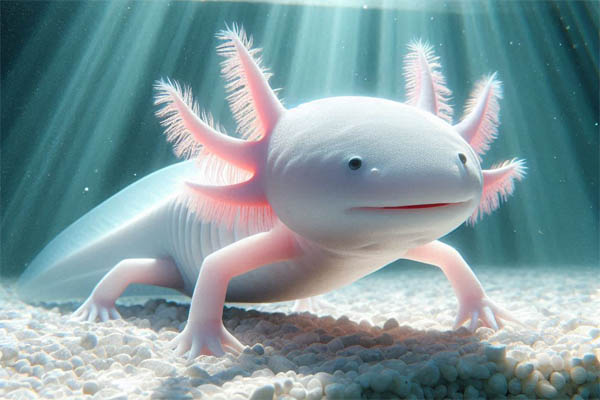
Leucistic axolotls are known for their pale, almost translucent pink or white body.
They feature dark, striking black eyes, distinguishing them from albino axolotls, which have pink or red eyes.
Leucistic axolotls retain some pigmentation in their skin, which gives them a soft glow under certain lighting conditions.
Their gentle appearance and friendly demeanor make them favorites among pet owners and breeders alike.
4.) Melanoid Axolotl
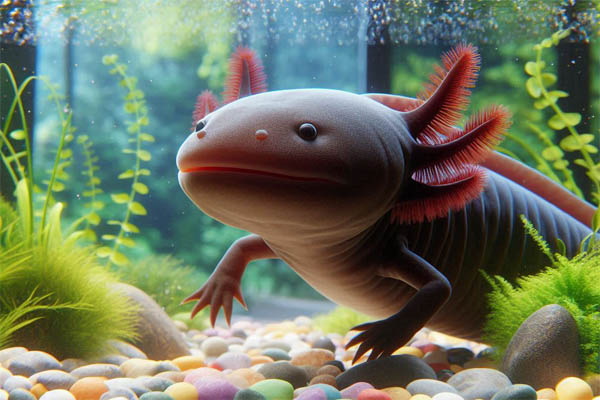
Melanoid axolotls are distinguished by their deep black or dark gray coloration.
They lack iridophores, which are the pigment cells that produce shiny, reflective qualities in other axolotl types.
This absence gives melanoids a matte finish that is visually striking.
They are often mistaken for wild-type axolotls due to their dark color, but their lack of shine sets them apart.
Melanoid axolotls are appreciated for their dramatic look and are commonly found in breeding programs.
5.) Hypomelanistic Axolotls
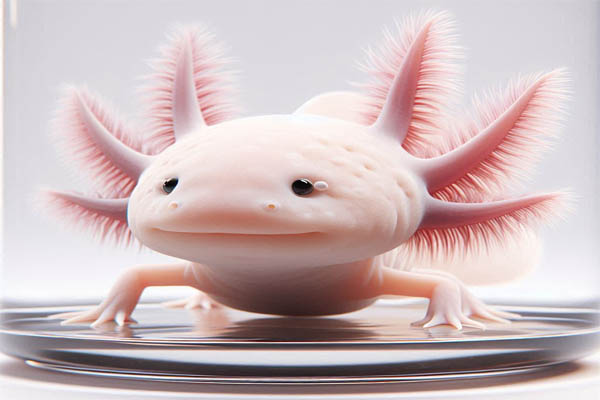
Hypomelanistic axolotls have a reduced amount of dark pigmentation, leading to a lighter coloration compared to the typical wild type.
They often display a yellow or pale appearance with some dark speckles or patterns.
This morph results from a genetic mutation that lowers melanin production, resulting in their unique look.
Hypomelanistic axolotls can be quite eye-catching, making them popular among collectors and breeders.
6.) Axanthic Axolotl
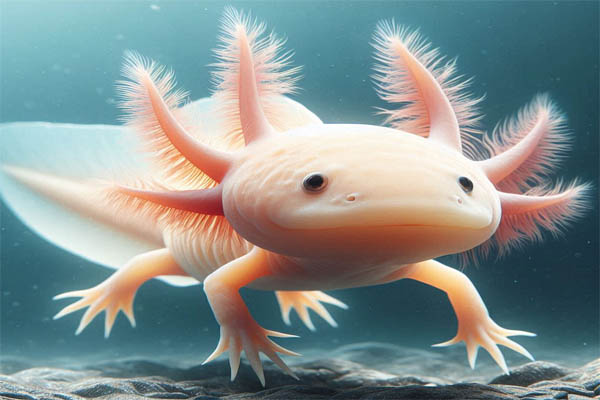
Axanthic axolotls are characterized by their gray or blue-gray color due to a lack of yellow pigmentation.
They often have a mix of darker patterns, making their appearance quite distinctive.
This type is sometimes confused with melanoid axolotls; however, axanthics retain some iridophores, giving them a less glossy finish compared to melanoids.
The axanthic morph adds variety to axolotl collections, as its unique coloration can be quite striking.
7.) Mosaic Axolotl

Mosaic axolotls display a combination of different colors and patterns, often featuring patches of black, white, and pink.
This morph is characterized by its irregular, patchy appearance, which can be a result of genetic mixing during breeding.
Mosaics can be incredibly visually striking, with each individual exhibiting a unique pattern.
Their diverse coloration makes them a favorite among breeders who enjoy the unpredictability of their offspring.
8.) Piebald Axolotl

Piebald axolotls are noted for their distinctive pattern of white and dark spots, creating a unique patchwork effect across their bodies.
This morph features irregular distributions of pigmentation, leading to an eye-catching contrast between the lighter and darker areas.
Piebald axolotls are often sought after for their unique and artistic appearance, making them a popular choice for pet owners and breeders alike.
9.) Wild Axolotl
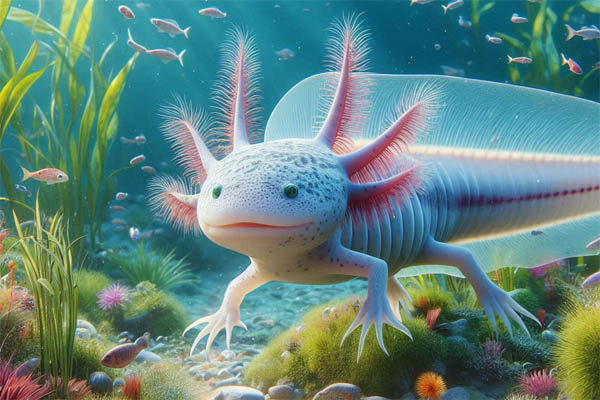
Wild axolotls are the original color variant, typically dark brown or black, often speckled with lighter colors.
This coloration provides them with camouflage in their natural habitat, helping them blend into muddy lakebeds and avoiding predators.
Wild-type axolotls are significant for breeding programs aimed at conservation, as they represent the natural form of this species.
10.) GFP Axolotl (Green Fluorescent Protein)
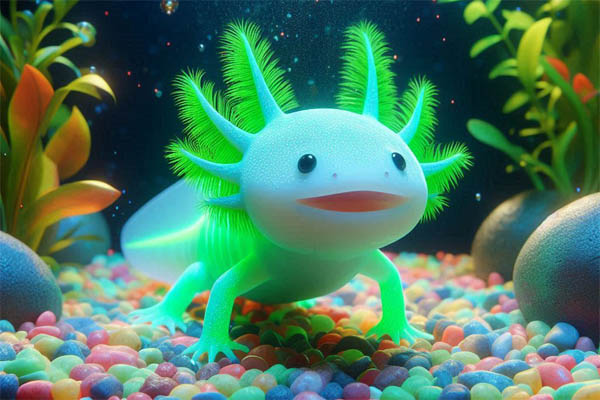
GFP axolotls are genetically modified to express green fluorescent protein, which allows them to glow under blue or ultraviolet light.
This modification is primarily used for scientific research, particularly in studies on regeneration and developmental biology.
While not a traditional morph, GFP axolotls are fascinating to observe, and their glowing property adds a unique dimension to their appearance.
Axolotl Types: Genetic Variations and Colorful Morphs
Axolotl types showcase a remarkable diversity, influenced by various genetic factors and environmental conditions.
Among the most notable axolotl types are those exhibiting albinism and leucism, which lead to striking color variations such as pink, lavender, and shades of brown or grey.
These unique traits arise from the interplay of chromatophores, which are specialized cells that contain different types of pigments, including melanin.
In some cases, genetic phenomena like polymorphism and mutation can result in intriguing variations, such as the dalmatian pattern characterized by freckles on the skin.
Furthermore, genetic engineering techniques have introduced features like green fluorescent protein, allowing certain axolotl types to glow under blacklight or ultraviolet light, a fascinating aspect that has captured the interest of researchers and pet enthusiasts alike.
Understanding the genetics behind these species not only enriches our knowledge of amphibians but also sheds light on broader concepts in animal coloration and habitat adaptability.
In captivity, selective breeding has also contributed to the development of unique axolotl types, offering a vibrant array of colors and patterns for pet owners.
With their distinctive tails, gills, and facial features, axolotls are not only captivating animals but also important subjects for studying cancer and other genetic phenomena.
Axolotl types exhibit an impressive variety of forms and characteristics, driven by genetic and environmental factors.
Among these, notable axolotl types include those exhibiting albinism and leucism, which result in vibrant colorations such as pink, lavender, and shades of brown or grey.
The color of an axolotl is determined by specialized cells known as chromatophores, which contain various biological pigments like melanin and contribute to the animal’s unique appearance.
In addition to these common morphs, certain axolotl types may present copper tones or even patterns resembling freckles.
Genetic phenomena like polymorphism and mutation can lead to fascinating traits within these amphibians, with the potential for unique patterns such as those seen in dalmatian morphs.
Some axolotls, particularly those created through genetic engineering, may express green fluorescent protein, allowing them to glow under blacklight or ultraviolet lighting.
This fluorescence is not just a stunning visual but also highlights the complexities of genetics in these organisms.
In captivity, selective breeding has allowed for the development of new axolotl types, offering a colorful array for pet owners.
The habitat of the axolotl, native to Mexico, is vital for understanding its adaptations and survival strategies, including responses to predation in the wild.
Research into axolotl species extends beyond their visual appeal, as they serve as important models in laboratories for studying cancer, human skin color, and even DNA repair mechanisms due to their remarkable regenerative abilities.
The anatomy of axolotls includes features like gills, a distinct face, and a tail that contribute to their survival and function in aquatic environments.
Their iris and pupil also play essential roles in adapting to different lighting conditions in their habitat.
With advancements in our understanding of their genetics and the creation of hybrid forms, including chimera axolotls, the world of axolotl types continues to expand, captivating both researchers and enthusiasts alike.
Axolotl types are renowned for their stunning variety and fascinating genetic traits, showcasing the incredible diversity within this unique amphibian.
Among the notable axolotl types are those exhibiting albinism and leucism, leading to vibrant color variations such as pink, lavender, and shades of brown or grey.
The color of an axolotl is primarily influenced by specialized cells called chromatophores, which contain various biological pigments like melanin and contribute to the animal’s striking appearance.
Additionally, certain axolotl types may display copper tones or even unique patterns resembling freckles, creating a diverse visual landscape.
Genetic phenomena such as polymorphism and mutation also play significant roles in defining axolotl diversity, leading to morphs with distinctive traits, including those reminiscent of a dalmatian with its characteristic speckling.
Some axolotls, especially those developed through genetic engineering, express green fluorescent protein, allowing them to glow beautifully under blacklight or ultraviolet light.
This fluorescence highlights the complexities of genetics and provides a unique insight into animal coloration.
In captivity, selective breeding has facilitated the emergence of new axolotl types, offering a captivating array of colors and patterns for pet enthusiasts.
Their native habitat in Mexico is critical for understanding their adaptations and survival strategies, including their response to predation in the wild.
Axolotls serve as essential models in laboratories for research, shedding light on important biological questions related to cancer, DNA repair, and even comparisons to human skin color.
Their remarkable regenerative abilities make them a valuable subject in laboratory studies.
Furthermore, the anatomy of axolotls includes features like gills, a distinctive face, and a well-defined tail, which enhance their survival and functionality in aquatic environments.
The iris and pupil play crucial roles in adapting to different lighting conditions, ensuring they thrive in their surroundings.
Moreover, the study of transparency and translucency in certain axolotl types adds another layer of intrigue to their biology, showcasing the multifaceted nature of their adaptations.
With ongoing research and discoveries, including hybrid forms such as chimera axolotls, the world of axolotl types continues to expand, capturing the imagination of both scientists and enthusiasts alike.
Axolotls showcase a variety of animal coloration, including shades like golden albino and deep melanistic.
Their colors play a vital role in predation, helping them blend into their environment.
Lighting significantly impacts how we perceive these colors. Under ultraviolet light, some axolotls, like the GFP morph, can fluoresce, adding to their appeal.
This fluorescence aids in scientific research, especially in studying regeneration.
The genetic factors influencing pigmentation in axolotls can also shed light on human skin color variations.
In places like New Zealand, breeders are exploring different axolotl types, producing unique tan hues.
Through captivating images, the rich diversity of axolotl colors highlights their beauty and adaptability in the animal kingdom.
Last Words
These axolotl types showcase the incredible diversity of color and pattern among these remarkable amphibians, appealing to both casual pet owners and dedicated breeders.
Each morph has its own unique characteristics that contribute to the charm and intrigue surrounding axolotls.

